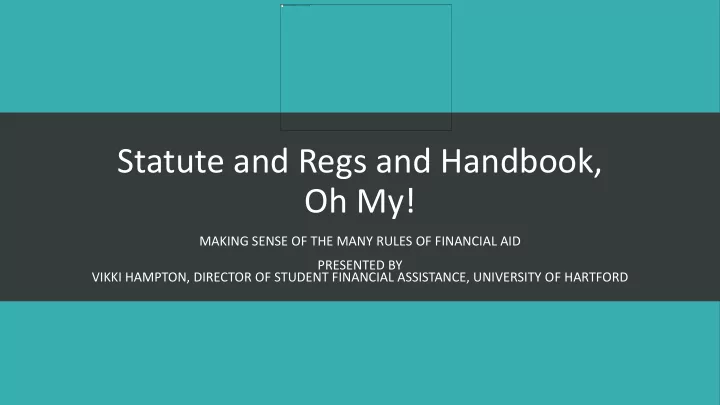

Statute and Regs and Handbook, Oh My! MAKING SENSE OF THE MANY RULES OF FINANCIAL AID PRESENTED BY VIKKI HAMPTON, DIRECTOR OF STUDENT FINANCIAL ASSISTANCE, UNIVERSITY OF HARTFORD
Agenda • Sources of rules • Roles of various entities in new and updated laws/regulations/guidance • Resources to navigate the web of rules • Role of Professional Judgment • Assessing compliance • Questions
NPRM IFAP EA Title HEA IV Regs Appropriations US DOE CFR Congress Statute President HEOA Reauthorization FSA Law Handbook
Where Does it All Begin? • Higher Education Act of 1965 (HEA) • Authorizing statute for federal student aid programs • Public Law enacted by Congress = Statute • Needs to be reauthorized about every 5 years • Higher Education Opportunity Act of 2008 (HEOA) • Intended to “amend and extend” the HEA, “and for other purposes” • Reauthorization of HEA • Appropriations • Occur annually • Not required for programs that are mandatory (e.g. Direct Loans)
Regulations • These are the rules that implement laws that were passed by Congress • US Department of Education: Office of Federal Student Aid • Regulations are compiled in a specific manner, with collaboration of aid community • 1. NPRM: Notice of Proposed Rulemaking: A draft is created and distributed for public comment Recent NPRM: • https://www.ifap.ed.gov/ifap/byFRType.jsp?type=Notice%20of%20Proposed%20Rulemaking%20(NPRM)&set= current • 2. Negotiated Rulemaking (Neg Reg) • After public comment, committee of stakeholders formed to negotiate • 3. Public Hearing • 4. Final Regulations published in Federal Register • 5. All final regulations are published annually in CFR (Code of Federal Regulations)
Sub-Regulatory Guidance Guidance created by Federal Student Aid to assist with implementation and use of regs Federal Student Aid Handbook Dear Colleague Letters Provide clarifications on laws and regs Long process of clearance required Broken down by types (e.g. GEN, CB, etc.) http://www.ifap.ed.gov/ifap/byYear.jsp?type=dpcletters Electronic Announcements Technical References Guides
Sub-Regulatory Guidance (continued) Electronic Announcements Quick information about processes and clarifications http://www.ifap.ed.gov/ifap/byAnnouncementType.jsp?type=11 Publications Examples: COD Technical Reference, ISIR Guide, SAR Comment Codes and Text, etc. http://www.ifap.ed.gov/ifap/publications.jsp Training Federal Student Aid Training Conference sessions: http://fsaconferences.ed.gov
Professional Judgment • From the Higher Education Act 479A: • Nothing in this part shall be interpreted as limiting the authority of the financial aid administrator, on the basis of adequate documentation, to make adjustments on a case-by-case basis to the cost of attendance or the values of the data items required to calculate the expected student or parent contribution (or both) to allow for treatment of an individual eligible applicant with special circumstances. However, this authority shall not be construed to permit aid administrators to deviate from the contributions expected in the absence of special circumstances….
Navigating the Web of Rules • NASFAA Members: Student Aid Index • http://www.nasfaa.org/StudentAidIndex • Ask Regs Interpretation of regs by NASFAA • • Caution – this may not be sufficient for auditors, but can help • Non-NASFAA Members • Start with IFAP http://www.ifap.ed.gov/ifap/ • For FSA Handbook, Technical References, Guides: Click “Publications” For DCL and EA: Click on “Letters & Announcements” • • For Regs and Statute Links: Click on “Laws & Regulations”
Stay on the yellow brick road! • To stay knowledgeable, I highly recommend that you subscribe to and read the following: • NASFAA Newsletter – Daily Summary • IFAP Weekly Subscription My IFAP New User Registration •
Tools to Help Assess Compliance • Have a program review! • Participate in the annual audit! • Or just assess your compliance in a less stressful environment • FSA Assessments: https://ifap.ed.gov/qahome/fsaassessment.html • NASFAA Self Evaluation Guides and Policies and Procedures Tools: http://www.nasfaa.org/Resources
Create a Culture of Compliance • Encourage staff and peers to subscribe to NASFAA Newsletter and IFAP Weekly update • Discuss key items during staff meetings • Create a comprehensive Policy and Procedures manual and review parts of it periodically for compliance • Have a peer who doesn’t normally participate in your area of expertise compare it to the regulations and guidance for an impartial assessment • Compliance is everyone’s job, not just the Director
Resources and References • Original HEA Act of 1965 Text http://c.ymcdn.com/sites/www.ncher.us/resource/collection/90515964- F9A5-45E4-83E5-06C2A26E3125/00004C57(OriginalHEAof1965).pdf • Full text of HEOA http://www.nacua.org/documents/heoa.pdf
Recommend
More recommend